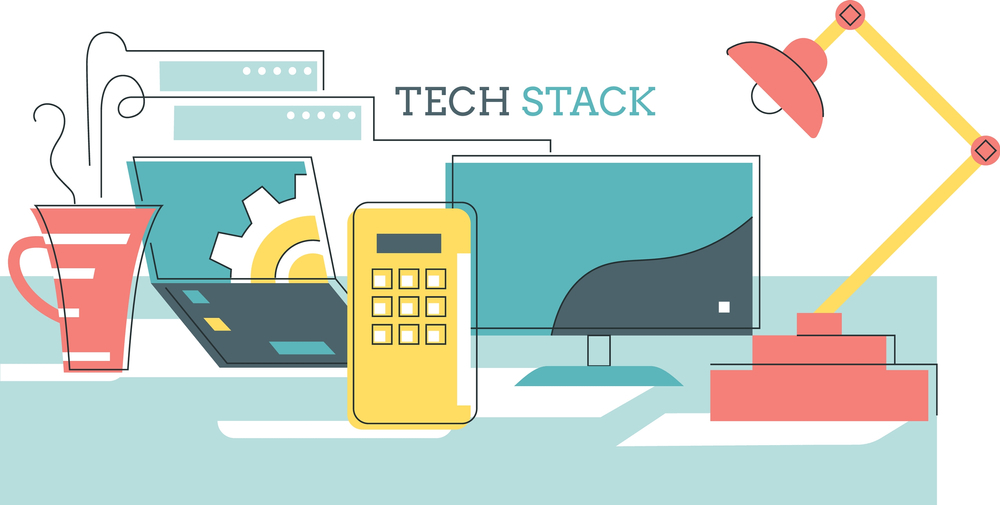Building a scalable web application is a complex process that demands careful planning and considerations. One of the most important factors to consider is technology stack, also known as tech stack. Building a robust tech stack is essential for businesses to grow immensely. Tech stack allows companies to handle user demands, increased workloads, and data without sacrificing performance.
In this blog, you will learn all the necessary information you need to know when building a tech stack for scalability.
What is Tech Stack?
A tech stack refers to the combination of technologies, frameworks, and digital tools. It is used for both mobile and web applications. It typically includes programming languages, frameworks, databases, frontend and backend tools, and cloud services. A tech stack is divided into two main components: the frontend (client-side) and the backend (server-side).
The frontend involves what users interact with directly, like websites or mobile apps, while the backend consists of servers, databases, and applications that manage data and operations behind the scenes. For a project’s performance, success, and overall scalability, it is crucial to select the right tech stack.
How To Choose a Tech Stack
While choosing a tech stack, the most important thing to consider is the size and purpose of the application to be built. The complexity of a tech stack is directly proportional to the size of the project. If the app to be created is large in size, then the tech stack used could be complex in terms of architecture. A large app is usually developed to manage huge amounts of data.
A large app means the tech stack is going to have multiple levels of frameworks and tools. For smaller or medium-sized projects, it is important to consider whether the stack is scalable and maintainable or not. At the initial stage of the app development, there might not be a large amount of data to deal with. However, if an application grows, the tech stack should be able to absorb new users on its own.
Factors To Consider In a Tech Stack
There are several factors to consider when selecting a tech stack to ensure it aligns with your project’s needs and future scalability. Here are a few factors to consider:
Project Requirements
You should align your project’s specific needs and consider what type of application you are building whether it’s a simple website, an e-commerce platform, a mobile app, or AI-driven system. Each project comes with unique functional, performance, and user expectations. For example, a real-time application like a messaging app might require technologies like Node.js for its event-driven, non-blocking architecture, while a content-heavy site may rely more on a robust CMS like WordPress.
Scalability
Scalability refers to the stack’s ability to handle increased burdens without compromising performance. The scalability is of two types; vertical and horizontal. The tech stack must support the ability to scale both the application and infrastructure easily as the user base grows. For instance, cloud services like AWS and Google Cloud offer scalable infrastructure, while frameworks like React and microservices architectures make scaling applications more efficient.
Development Speed
The time taken to develop and launch the application is often a critical factor. Some languages and frameworks like Python, allow rapid development by offering pre-built modules and libraries that can streamline coding. This feature is crucial for startups or projects with tight deadlines. Moreover, the ease of use for developers can reduce the learning curve and accelerate the development process. Therefore, choosing a tech stack that allows rapid development is key to keeping up with the competition.
Performance
Performance is about how fast and efficiently an application responds to user requests and processes data. For high-performance applications, you need to consider the processing speed of the chosen languages, database performance, and the server’s ability to handle traffic. A high-performing tech stack ensures a seamless experience for users, especially when scaling to accommodate more traffic.
Security
Security and safety are critical factors especially when dealing with sensitive data like financial or personal information. The tech stack must follow the security best practices like encryption, secure authentication methods, and regular security updates. Choose those tools and frameworks that ensure your application is less vulnerable to breaches. Moreover, using DevSecOps practices and security tools like Azure can help in maintaining security.
Cost
In addition to the development cost, one must consider additional expenses like licensing fees and the cost of hiring developers with advanced skills can be high.
Tech Stack Layers
The tech stack consists of 5 layers:
Operating System (OS)
It is the foundation that manages hardware and supports software operations.
Web Server
It manages HTTP requests and delivers web content to users.
Server-Side Programming
It involves languages and frameworks that handle logic, data processing, and server communication.
Client-Side Programming
It executes the code on the user’s device, handling the UI and UX.
Frontend Frameworks
It enhances interactivity and maintainability of the user interface.
Conclusion
Choosing the appropriate tech stack is a crucial decision that leads to success or failure of your software development project. Seek help from professionals to benefit their expertise, experience, and industry insights. To make informed decisions that align with your business goals, it is important to have the right tech stack by your side. Whether you are a startup or established business, professional guidance can help you overcome complexities of tech stack solutions leading to more safe, secure, efficient, and successful software.
